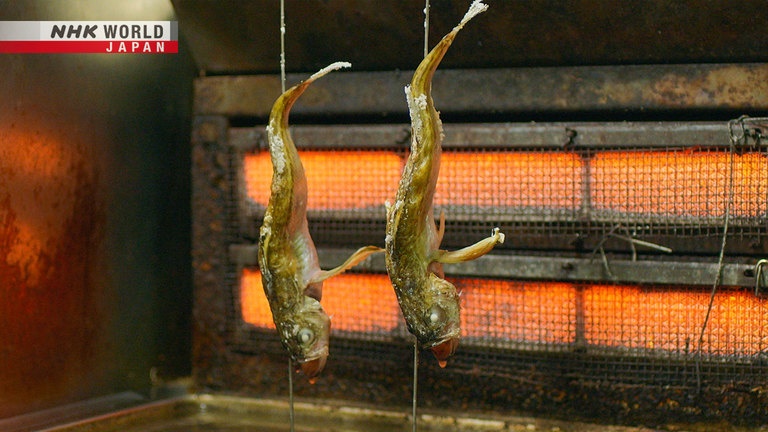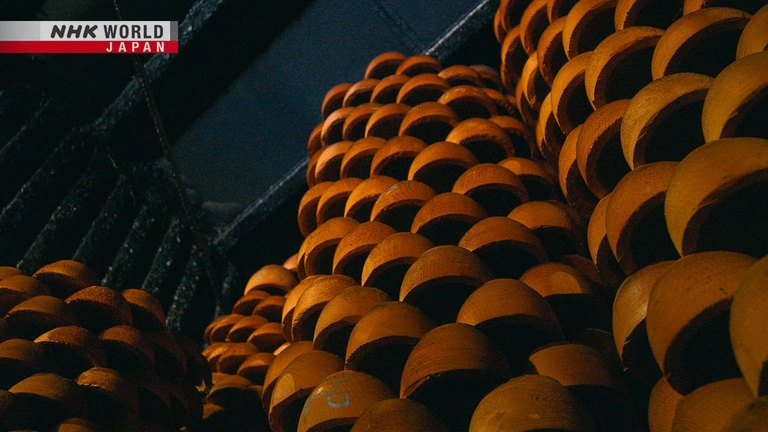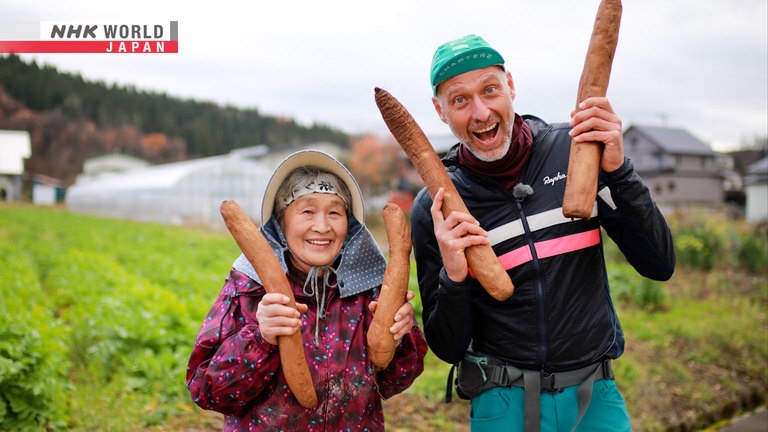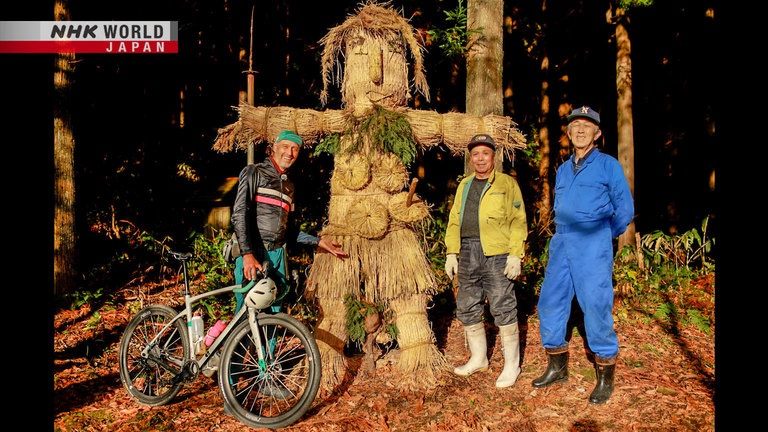Akita - The Wisdom of Nature
From sea to mountains, nature in Akita Prefecture is spectacular. As we ride through the gales of late fall, we see people preparing for the long snows of winter with pickles and preserves. We visit a village where an 800-year-old lacquerware tradition uses timber made fine-grained and strong by the harsh winters. Among the rice paddies we find farmers crafting a huge straw guardian deity, and in a mountain village we meet a man living the ancient way, where everything in life is a gift from the nature gods.




Transcript
The best way to discover little-known sights and make even familiar places feel brand new, is to go exploring by bicycle.
This time, our road takes us through Akita.
With majestic mountains and a spectacular coastline, Akita has some of Japan's finest scenery.
We're here in the last days of autumn.
And the locals are preparing for the approaching winter snows.
An open fire pit!
These pickles will be so tasty.
- Have you ever seen this before?
- Never.
For many, the way of life here remains close to nature, with a tradition of sharing nature's bounty.
Most people say they pick mountain vegetables or catch fish.
But in this area we say we receive gifts from nature.
We'll hear what it's like to live in the heart of mother nature.
Come with us now, on a 390-kilometer ride through the countryside of Akita.
Akita prefecture lies in the north of Honshu island, with a coastline facing the Sea of Japan.
We'll set off from the capital, Akita City.
Our cyclist this time is Michael Rice, from the USA.
Michael moved to Japan in 1991.
An all-round athlete, he's competed in numerous triathlons.
There are so many people living in Japan with the old style of life.
And Akita prefecture is really one of those places.
So we're really going to go into the deep part of Akita and see the lifestyle of people that has been for thousands of years.
Okay, we're ready for our adventure.
Let's go.
This will be a four-day trip.
On day one, we'll be riding south along Akita's beautiful coast.
Days two and three will take us inland to explore an area of rich farmland.
And we'll end the ride on day four, high in the mountains on the eastern edge of Akita.
Here we'll see how Akita mountain folk still live the traditional way, in harmony with nature.
What a beautiful morning to start the ride.
It's a little cold but a beautiful morning in Akita.
Oh, that's a big river.
I wonder where we can see the sea.
Look for the ocean, oh, there's the ocean.
The ocean!
Sand beach.
Welcome to the Sea of Japan!
I can touch the waves.
I'm riding in the ocean!
Cycling through the ocean.
Oh, the wind is so strong.
It's really whipping up the waves here.
Woah, the wind's about to blow me over.
From autumn through winter, strong gales blow constantly off these seas.
I think I see a fishing port.
Ah, this looks like the place where they bring the catch in.
We've arrived just in time for today's fish auction.
Fishing must be hard work
in the strong winds you get here.
Yes, the sea is really rough
from now through winter.
The big waves mostly stop us going out.
- So on good days you seize your chance?
- In this season we catch the most different kinds of fish.
Where are the fish?
Michael, seafood gourmet, goes searching for a fish restaurant.
I see one that says sakanaya-san - fish shop and kitchen.
Wow! So many kinds.
They all look so delicious.
Everything you see is locally caught.
These are really big.
What do you recommend?
In this season, hatahata sandfish.
These? I've never heard of hatahata.
They're caught all along the Sea of Japan coast.
But I think we eat them most in Akita.
Buy fish here, and they'll cook it for you on the spot.
Born and raised in Nikaho, Sato Shuichi has been a fishmonger here for 45 years.
I like it fine right here.
I've hardly ever been out of Akita.
- What's so good about Akita?
- We have it all here.
Fantastic scenery and food
from both sea and mountains.
Not a lot of entertainment, but that doesn't bother me.
I like peace and quiet.
- Here you are.
- Wow. That looks amazing.
Okay, this all looks so delicious.
Okay, I'm going to start with the cooked fish.
The eggs.
I love fish eggs.
They spawn near here at this time of year.
Lots of fat, so they are very tasty.
This is really, really a delicious fish.
Now for a unique Akita kind of sushi.
This is the same fish, pickled in salt.
We always eat it like this at new year.
Salt-pickled hatahata is marinated with rice and vinegar for about a month to make this sushi.
It was originally a way of preserving food to survive Akita's long, bitter winters.
This changes my concept of what sushi is.
We think of sushi as a big ball of rice with some fish on it.
So they didn't cook the fish at all.
This is just the sliced fish.
So good.
I like this job, because I can really feel
I'm making people happy.
I'm not from a fishing family,
so I don't go out to sea myself.
But I make my living from our local fish.
The sea supports everyone's livelihoods.
To end the first day, Michael is heading for a hill overlooking the sea.
I thought we might get a good view of the sunset.
Yeehaw, there's the ocean, the mountains, the sunset, the pastures, the fields.
This is Akita.
Far off in the distance is Mount Chokai, the symbol of Akita.
This is spectacular, really spectacular, wow.
Every direction, it's so beautiful.
That mountain up ahead.
Wow!
It's so beautiful here.
The coastline, and the sunset here.
If this is day one, I can't wait for day two, three, and four.
We start day two in an area of lakes and wetlands at the foot of Mount Chokai.
Wow, that's so breathtaking.
Beautiful.
Heralding the coming of winter, in late November flocks of swans migrate here from Siberia.
We're now in the town of Masuda.
Historically, this was a town of merchants, a hub for Akita's inland trade.
The old shopping area.
I love these old buildings.
Oh, look at this place.
Wow, this is a nice one.
"Uchikura." A kura is like a storage building.
- Welcome! Come in.
- Hello!
- What is that in there?
- It's called an uchigura.
Storehouses were often built inside homes in Masuda,
and we still have lots like this.
Storehouses are normally outside.
Masuda has such heavy snowfall
people here started building them indoors.
The snow here gets so deep it will simply bury the entrance of an outdoor storehouse.
This family built their indoor storehouse 143 years ago.
It also contains a tatami mat space used for important family ceremonies.
Everything still looks brand new.
How do you keep it in such good condition?
See how shiny the walls are?
We lacquer all surfaces to protect them.
A lacquer coating on all the wood.
This area has a long tradition of lacquer crafts.
Michael has arranged a visit to a lacquer workshop in the nearby town of Kawatsura.
Ah, this is the place.
I think this is it.
Anyone home? Ah, Sato san?
I'm Michael. Nice to meet you.
Pleased to meet you.
Sato Fumiyuki's family have been lacquer artisans here for over 150 years.
These are the kind of bowls we make.
Here, take a closer look.
It's beautiful.
Lacquer is the sap of the lacquer tree.
I carve the bowl from a piece of horse chestnut,
then apply several coats of lacquer.
The history of Kawatsura lacquerware goes back 800 years.
These beautiful products are also tough and durable, designed for everyday household use.
The raw materials come from local forests.
We cut a large trunk into round slabs.
All our wood is local, or from nearby Iwate.
- What's so good about Tohoku wood?
- The grain.
Our heavy snowfall makes the trees grow slowly,
so the grain is very fine.
See how close together the rings are.
It looks very tough.
After the bowls are carved from blocks of wood, they're dried using a traditional method.
This is so cool. It's like a work of art.
We stack the bowls in here, and build a fire underneath.
- Down there?
- So the smoke rises through the bowls.
I can really smell the smoke.
The smoke strengthens the wood,
and makes it resistant to insects.
The same way hearths in thatched houses
add more strength to the pillars and roof.
Each artisan has their own recipe for mixing lacquer sap with pigment.
Temperature and humidity affect the time the lacquer takes to harden, so conditions in this room must always be kept constant.
The exact amount they need that day is strained through washi paper to filter out any dust or dirt.
A feature of Kawatsura lacquerware is
the thick coating we apply.
Sato is a perfectionist - he'll only use the very best lacquer from domestically grown trees.
- That tree with all the scars?
- Yes, this is a lacquer tree.
Ten years ago, Sato took on the difficult challenge of producing lacquer himself.
I use this tool to cut horizontal grooves.
That makes the sap ooze out slowly.
So each area has different lacquer?
Yes, because the soil is different.
Kawatsura lacquer is a deeper red.
It's a high quality lacquer that produces a very dense,
strong coating.
Made with only local lacquer on local wood,
these bowls just feel so right to hold.
And they will stand up to years of daily use.
At the start of day three, we're entering an area of rich farmland in the center of Akita.
Oh, beautiful day.
I love these little farm villages.
Doing greenhouses here.
There's some farmers.
Let me talk to them.
Hello! What's that you're harvesting?
Daikon radishes, for pickling.
- Specifically for pickles?
- That's right.
Sounds tasty.
Do you just pull them up?
Yes. Grab the middle like this and tug.
Takahashi Kiyoko is a rice farmer as well as a vegetable grower.
It's hard to balance.
I feel they're all going to spill out.
Just before winter arrives is peak season for making pickles.
Oh! I see smoke.
This is where I dry the daikon.
Amazing! An open fire pit!
The fire's been going two days now.
I'll give it two more days.
- Can I go inside?
- Sure.
Wow. It's completely full of daikon.
- How many are in here?
- About 1,000.
They're already partly dried.
Look how wrinkled they've become.
Made me cry.
This looks like a lot of work.
It's the old way to preserve food.
So you do this before winter comes?
Yes. This area will be covered in deep snow,
no way to get fish or vegetables.
That's why we preserve daikon in fall.
These pickles will be so tasty.
Smoked and dried vegetables last longer than those simply pickled fresh with salt.
- Have you ever seen this done before?
- No, never.
Takahashi is famous locally for her pickling skills.
She pickles over 5,000 daikon radishes every year, and they sell out the moment they're ready.
- Try this. It's daikon I pickled last year.
- The famous Akita smoked daikon pickles.
We call them Iburi Daikon.
Take a big bite.
Very tender.
Compared to normal pickles
it's crunchy outside and tender inside.
And I can taste the smoke too.
Very tasty!
I'm glad you like it.
Why is Akita famous for pickles?
I think it's because we had to make them
in order to survive our long winter snows.
You couldn't just go to the shops and buy food back then,
you had to make your own.
It's a tradition passed from mother to daughter.
I make it because people still demand it.
This is really a farming region.
All about farming, everything.
Oh, look at that gate.
And the beautiful shrine.
Ah, there's another shrine.
This one's totally different.
It's a white gate and the shrine is covered to protect it from the snow.
I wonder what that thing is.
I'm going to take a look.
That's interesting.
I've never seen this in any other part of Japan.
It even has a face written on it.
I guess this is to protect the rice fields.
I guess it's like a giant scarecrow or something.
Oh, there's a little shrine here.
Oh, look at that!
There's another big scarecrow.
It's good, the gods are watching over.
And the scarecrow is watching over too.
It even has black hair.
What is that?
What?
That thing shaped like a human.
Oh, that's a Yakujinsan.
This is a farming area so it's vital our people
and our crops stay healthy.
These effigies ward off disease and crop failure.
This one is getting a bit worn out from the wind and rain.
In spring, we'll spend a whole day making
a new one for the shrine.
You're seeing him at his worst.
Hearing a new straw effigy has just been completed nearby, Michael goes off to take a look.
Hello! I'm Michael.
Hello.
- This is where you make them?
- Yes, just back there.
Oh, I see it! Can I go closer?
Of course. Come on.
This is really big.
It must be over three meters tall.
Yes, about that.
When did you finish it?
I think it was the 23rd of last month.
It's still brand new.
- I get a really powerful feeling from it.
- Well, it is our guardian deity.
- Is it male or female?
- Both.
It has both symbolic male and female body parts.
It's mysterious.
This is all straw, even the mouth and nose.
We used bamboo leaves for the eyes
to make them stand out more.
And cedar leaves for hair under the armpits.
And for the chest.
The chest hair makes it look strong.
Here are some photos of us making it.
We each made a different part.
It took surprisingly little time.
It's really a harvest thanksgiving.
An important event in the village year.
When it's done, we celebrate with a drink.
A guardian deity to protect their community, with everyone taking a hand in its construction.
Today we're climbing up into the mountains that line Akita's eastern edge.
Cold breeze!
There's a real chill.
The water is so clear.
What a beautiful stream.
It's great.
In villages deep in these mountains, people still follow the ancient traditions in their daily lives.
I'm going to get a nice downhill from here.
Michael spots his destination, the village of Ani.
Ok, I'm looking for Matsuhashi ryokan.
That's it.
This is it.
- Hello?
- Coming!
- I'm Michael.
- I've been expecting you.
Matsuhashi Toshihiko is the owner of this ryokan.
Please, have a seat.
Wow. Like going back in time.
Yes, nothing's been changed.
Why all the furs?
They're animals my father hunted in the mountains.
And some I hunted too.
So you come from a family of hunters.
Around here we don't say hunter,
we call them "matagi."
What's the difference?
Matagi has more a feeling of someone
who lives in harmony with the mountains.
A short walk will take them into the mountain forest.
- A beautiful stream.
- This is the Hitachinai River.
I come and fish here in the mornings.
They must be easy to spot in this clear water.
Yes, look closely and you'll see lots.
- Look here Michael. Mountain wasabi.
- Really?
It grows where there is running water.
The parent plant has lots of young shoots.
We just take the rhizome, the main part,
and leave the shoots to keep growing.
Wasabi is a tough plant. These shoots will quickly
put down their own roots.
But they take years to grow to full size.
Yeah, I can smell the wasabi, horse radish.
People normally say catch fish or gather plants,
but we use a different word here.
We matagi say we have been given these things.
We go into the mountains to receive gifts.
I'll come down and say
I was given fish or plants today.
- So who gave you these gifts?
- The mountain gods.
A matagi believes that life is a gift from the mountains.
Matsuhashi has recently acquired an apprentice.
This is Yamada.
He came to live here because he's fascinated
by our matagi way of life.
Yamada moved to the area after graduating from university in Osaka.
Matsuhashi is teaching him the matagi way of life as they trek the mountains together.
Kentaro, look over there.
In the middle of all the white beeches,
one tree is different.
That one with all the high branches is an oak.
Oaks might have maitake mushrooms.
Keep that in mind.
I think I see mushrooms.
There, under that fallen tree.
Yes, there they are.
Well spotted, right across the stream.
The forest is different there - a bit reddish.
That's how I spotted them.
A town-dweller wouldn't see anything.
Like with those mushrooms,
he sees so much that I can't even if I concentrate.
He spots anything different instantly.
It's as if his eyes see the mountainside
at a much higher resolution than ours.
This is a grape vine.
I've found some.
Mountain grapes.
Look over there. Bear claw marks.
- They go pretty high up.
- Bears around here climb to eat grapes.
You can see how far up he climbed.
In the autumn and winter seasons, matagi will hunt for bear.
If I'm lucky, the mountain will give me a bear.
But wild bears are smart and usually get away.
When a group of matagi come out,
we share everything we get.
We all take home the same amount of meat.
So if there are three of us,
we divide it three ways, if five, five ways.
Master or first-timer, all get the same.
We're in luck. There are still nameko here.
- You've found mushrooms?
- Yes, nameko.
These look really tasty.
These are nameko.
- Look, more underneath.
- Lucky!
A gift of mushrooms from the mountain gods.
Here you are, Michael.
- All gifts from our local mountains.
- This looks great!
Iwana trout, from a mountain stream.
And nameko mushrooms with daikon radish.
Real nameko. It feels like I've been eating
the imitation all this time. So smooth.
- Yes, they have a slippery texture.
- The taste is very pleasant.
Where did you get all this knowledge
about the mountains?
From my father. He taught me nothing belongs to us,
it's all gifts from the mountain.
And so we must share it with anyone who comes.
That's how I try to live my life.
Most people today think you have done well
if you make a lot of money.
But people here live according to a completely
different set of values.
It really feels like living in a different world.
It's really all about living in harmony with nature.
Not doing anything to excess.
In this area, deep in the mountains,
we're still surrounded by the richness of nature.
Let's get to the goal.
The road will take Michael around Lake Tazawa to his goal, Mount Akita Komagatake.
Oh, beautiful, really beautiful.
Beautiful.
Ah, this is steep.
There's his goal now, the mountain on the right.
I can't wait to see the view from up here.
Wow, look at that view! That's it.
That's what I've been looking for.
Made it!
Akita's harsh winter months are just around the corner, but today this land is still bathed in the golden glow of autumn.
I can see just overnight the mountains just got fresh snowfall.
And the people here really live at one with nature.
Coming along the ocean, seeing how strong the winds are and how high the waves are, but yet seeing the delicious fish that they get this time of year,
and then going inland and seeing how they prepare.
They really understand nature, they go into the forest, into the mountains, and that's the wisdom of generation after generation of living in this harsh environment.
They really understand that they need to be at peace with nature and use the things that mother nature brings them.
Times change, but the wisdom of nature is a gift that never stops giving.